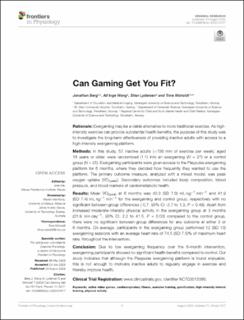| dc.description.abstract | Rationale: Exergaming may be a viable alternative to more traditional exercise. As high-intensity exercise can provide substantial health benefits, the purpose of this study was to investigate the long-term effectiveness of providing inactive adults with access to a high-intensity exergaming platform. Methods: In this study, 52 inactive adults (<150 min of exercise per week), aged 18 years or older, were randomized (1:1) into an exergaming (N = 27) or a control group (N = 25). Exergaming participants were given access to the Playpulse exergaming platform for 6 months, where they decided how frequently they wanted to use the platform. The primary outcome measure, analyzed with a mixed model, was peak oxygen uptake (V̇O2peak). Secondary outcomes included body composition, blood pressure, and blood markers of cardiometabolic health. Results: Mean V̇O2peak at 6 months was 42.3 (SD 7.0) mL⋅kg−1⋅min−1 and 41.9 (SD 7.4) mL⋅kg−1⋅min−1 for the exergaming and control group, respectively with no significant between-group differences (-0.7, 95% CI -2.7 to 1.3, P = 0.49). Apart from increased moderate-intensity physical activity in the exergaming group at 3 months (21.9 min⋅day−1, 95% CI: 2.2 to 41.5, P = 0.03) compared to the control group, there were no significant between-group differences for any outcome at either 3 or 6 months. On average, participants in the exergaming group performed 12 (SD 13) exergaming sessions with an average heart rate of 74.5 (SD 7.5)% of maximum heart rate, throughout the intervention. Conclusion: Due to low exergaming frequency over the 6-month intervention, exergaming participants showed no significant health benefits compared to control. Our study indicates that although the Playpulse exergaming platform is found enjoyable, this is not enough to motivate inactive adults to regularly engage in exercise and thereby improve health. | en_US |
| dc.description.localcode | Copyright © 2020 Berg, Wang, Lydersen and Moholdt. This is an open-access article distributed under the terms of the Creative Commons Attribution License (CC BY). The use, distribution or reproduction in other forums is permitted, provided the original author(s) and the copyright owner(s) are credited and that the original publication in this journal is cited, in accordance with accepted academic practice. No use, distribution or reproduction is permitted which does not comply with these terms. | en_US |

